Results 1 to 30 of 228
Thread: FTL and Violating Causality
-
2018-01-17, 11:56 AM (ISO 8601)Ettin in the Playground


- Join Date
- Aug 2011
- Location
- Sharangar's Revenge
- Gender

 FTL and Violating Causality
FTL and Violating Causality
A discussion in the Roleplaying forum got into FTL travel/communications and how it violates causality. Those of you who are experts in this field, can you explain how something like this could happen by allowing FTL communications?
For example, Person A sees Saceship B explode Planet C, then transmits this information instantaneously to Spaceship D traveling at Speed Ec, enabling someone on the spaceship to prevent the exploding. Assuming the light from the shooting reaches Person A before it reaches Spaceship D, of course.Warhammer 40,000 Campaign Skirmish Game: Warpstrike
My Spelljammer stuff (including an orbit tracker), 2E AD&D spreadsheet, and Vault of the Drow maps are available in my Dropbox. Feel free to use or not use it as you see fit!
Thri-Kreen Ranger/Psionicist by me, based off of Rich's A Monster for Every Season
-
2018-01-17, 12:02 PM (ISO 8601)Titan in the Playground


- Join Date
- May 2016
- Location
- The Lakes
 Re: FTL and Violating Causality
Re: FTL and Violating Causality
The past explanations I've seen have usually come down to "getting information to a place before light would get it there is bad because it's bad for information to get there before the light does", which is the "explanation" -- and/or presume that FTL travel in a setting automatically implies relativistic velocities are possible for vessels not traveling FTL.
It is one thing to suspend your disbelief. It is another thing entirely to hang it by the neck until dead.
Verisimilitude -- n, the appearance or semblance of truth, likelihood, or probability.
The concern is not realism in speculative fiction, but rather the sense that a setting or story could be real, fostered by internal consistency and coherence.
The Worldbuilding Forum -- where realities are born.
-
2018-01-17, 12:06 PM (ISO 8601)Ettin in the Playground


- Join Date
- Jun 2013
- Location
- Bristol, UK
 Re: FTL and Violating Causality
Re: FTL and Violating Causality
 The end of what Son? The story? There is no end. There's just the point where the storytellers stop talking.
The end of what Son? The story? There is no end. There's just the point where the storytellers stop talking.
-
2018-01-17, 12:12 PM (ISO 8601)Ogre in the Playground


- Join Date
- Nov 2015
- Location
- Right behind you!
- Gender

 Re: FTL and Violating Causality
Re: FTL and Violating Causality
If that's all it is - then you couldn't ever stop something once you've seen it occur. Just the opposite - once you've seen it at light speed it happened long ago.
Now - you could communicate to someone so that they could dodge something - even a laser - since you can see it and then FTL ahead of it, but not once it's already hit home.
*shrug* But - I'm not a physicist.Last edited by CharonsHelper; 2018-01-17 at 12:13 PM.
-
2018-01-17, 12:26 PM (ISO 8601)Titan in the Playground


- Join Date
- Oct 2009
- Location
- In my library
 Re: FTL and Violating Causality
Re: FTL and Violating Causality
I'm not an expert, but as I remember it has to do with time cones (or how you view time), and how they skew as you're moving towards c (which I always think of as 'infinite energy' for anything with mass). So when your velocity gets to greater than c your time cone is skewed to the point where no part of it is aligned with an 'at rest' observer, and so something something information something something time travel.
Anyway, question for people who understand this stuff. Let's assume that we can make a wormhole so that point A (let's say the center of mass of the Palace of Westminster) is next to point B (let's say the highest atom on Olympus Mons) are next to each other through the wormhole. Am I right in thinking that although the Palace of Westminster and Olympus Mons are for all intents and purposes less than a metre apart through this wormhole, any information sent though it would still fall into the problem of travelling FTL and (at least conventionally) violating causality?
-
2018-01-17, 12:28 PM (ISO 8601)Titan in the Playground


- Join Date
- May 2016
- Location
- The Lakes
 Re: FTL and Violating Causality
Re: FTL and Violating Causality
There are two separate questions here.
One is, how is it that a particular form of FTL would enable you arrive back a location before you left that location? How that allows causality violations should be fairly obvious, right?
The other is, why would ALL forms of FTL allow causality violations?It is one thing to suspend your disbelief. It is another thing entirely to hang it by the neck until dead.
Verisimilitude -- n, the appearance or semblance of truth, likelihood, or probability.
The concern is not realism in speculative fiction, but rather the sense that a setting or story could be real, fostered by internal consistency and coherence.
The Worldbuilding Forum -- where realities are born.
-
2018-01-17, 12:34 PM (ISO 8601)Titan in the Playground


- Join Date
- May 2016
- Location
- The Lakes
 Re: FTL and Violating Causality
It is one thing to suspend your disbelief. It is another thing entirely to hang it by the neck until dead.
Re: FTL and Violating Causality
It is one thing to suspend your disbelief. It is another thing entirely to hang it by the neck until dead.
Verisimilitude -- n, the appearance or semblance of truth, likelihood, or probability.
The concern is not realism in speculative fiction, but rather the sense that a setting or story could be real, fostered by internal consistency and coherence.
The Worldbuilding Forum -- where realities are born.
-
2018-01-17, 12:35 PM (ISO 8601)Ogre in the Playground


- Join Date
- Jul 2013
- Location
- Dixie
- Gender

 Re: FTL and Violating Causality
Re: FTL and Violating Causality
As I said in my previous post, it's explained here better than I could. This is the source for my information and images.
It has to do with the fact that the speed of light is defined based on universal constants, meaning it will be the same for all observers. That one fact is what leads to all kinds of weirdness with space and time as you approach lightspeed, and why simultaneous events aren't really simultaneous.
First off, when anyone says "velocity," your first question should be "velocity relative to what?" If you see me tearing along at .999c, you'd say I am moving pretty dang fast. In my frame of reference, I'm sitting still, and you're the one going .999c. Which of us is correct? As long as no one is accelerating, it doesn't matter which reference frame is used. All inertial reference frames give the exact same results.
At first, that doesn't seem like that meshes with the idea that the speed of light is constant. In the above example, if I fired a laser ahead of me, you would see the end of the laser going away from me at a piddly .001c. It's actual velocity relative to you is 1c, but I am also going close to 1c. From my perspective, that same laser beam is travelling away from me at 1c, despite the fact that the separation velocity I see is 1000x that which you see. That's because of space and time dilation.
If we construct a space-time diagram for an observer, we can do so as a simple x-y graph, considering only one spatial dimension (or compressing all 3 into one, same effect) as the x-axis and time as the y-axis. For convenience (you'll see why in a second), each mark on the x-axis (space) is one light-second, and each mark on the y-axis (time) is one second. Thus, an event that occurs 3 light-seconds to the left and one second before the observer's current time would be placed at (-3, -1) on the graph.
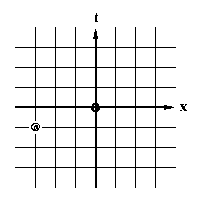
Event is at the @
If another observer, say moving along at 1/3c, passes by our initial ("stationary") observer at time t=0, their position would look something like this:
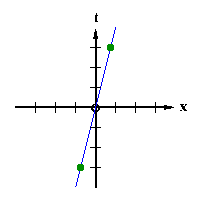
Because of the fact that light travels (by definition) one light-second in one second, light moves along 45 degree angles on this graph.
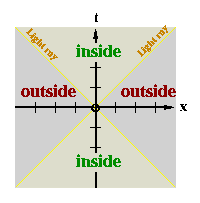
Things "inside" the light cone can either influence or be influenced by actions at t=0, since the observer there will see an event in the past or be able to send a signal to the point in the future. Things "outside" the light cone cannot influence or be influenced, since light cannot travel far enough in time. Observers later might argue whether events outside the light cone are simultaneous, but (if we restrict things to non-FTL) they will remain firmly in the past for both, so they cannot be influenced.
Again, because the speed of light is based on a physical constant, it moves along 45-degree lines on any space-time graph, not just the one for our "stationary" observer. So, we can construct axes for our moving observer as well, using methods which you can read about in the above link.
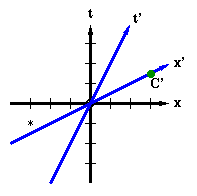
x' is the space axis for a moving observer, and t' the time axis (Remember this is relative--you could shift to a reference frame where our "moving" observer was stationary, and our "stationary" observer would be moving. Basically you rotate both sets of axes until our "slanted" ones are straight and our straight ones are slanted. Again, more detail on this in the link.) The event marked with an * is below the x axis (in the past for our stationary observer) but above the x' axis (in the future for our moving observer).
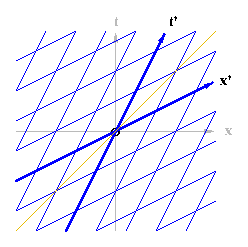
These are lines of constant space and constant time for our moving observer. Anything below the x' axis is in the past, and anything above it is in the future. Anything along a line of constant time is simultaneous for that observer. Note that there are events, such as our event earlier at (-3, -1), which are in the past for our stationary observer but in the future for our moving observer. This is where the problems come in.
Now, because this event is outside of the light cone, this normally isn't a problem. At t=0 when the observers pass, the light from the event hasn't reached them yet, so neither of them CAN KNOW about the event, nor influence it. Even for the moving observer, for whom the event has not happened yet, he cannot reach it in time to affect it, either by presence or information, since it is outside of the light cone--that would require travel or communication faster than light. Same for the stationary observer; even though it's in the past he hasn't seen the event yet so can't tell the mover about it. Later on, once it is in their light cones, they can argue about whether it had happened when they passed one another, but at this point it will firmly be in the past for all involved and thus the question can't cause a paradox.
But, if you have FTL communication or travel of any sort, this breaks down. Say the event is person C murdering person D. The stationary observer, person A, has an instantaneous video feed watching D, and sees D die. The body is there on the screen. A tells B (our moving observer) as they pass, and B sends an instantaneous message to his friends at (-3,-1) to kill C. Which they do. But, in B's reference frame, the instantaneous message was sent--and arrived--BEFORE C murdered D. Thus the cause of the event cannot occur, as C is dead. But what does A see? D was already dead for him. That is what a causality violation looks like.
It's not related to whether you have travel but not communication or vice versa, it's not related to how you get around the speed of light limitations (note I never said how these instantaneous messages were sent). It's a property of relativity and the distortions that occur in time and space. Again, the link I posted explains the concept in far more detail than I, but this is how it works in a nutshell. It's hard to get good, condensed answers, because frankly relativity is a complicated mess that does not at all work intuitively.Last edited by rs2excelsior; 2018-01-17 at 12:39 PM.
I'm playing Ironsworn, an RPG that you can run solo - and I'm putting the campaign up on GitP!
Most recent update: Chapter 6: Devastation
-----
A worldbuilding project, still work in progress: Reign of the Corven
Most recent update: another look at magic traditions!
-
2018-01-17, 12:38 PM (ISO 8601)Ogre in the Playground


- Join Date
- Jul 2013
- Location
- Dixie
- Gender

 Re: FTL and Violating Causality
Re: FTL and Violating Causality
As I've said before, the particular form doesn't matter. At all. This is all due to the fact that simultaneous events aren't simultaneous in all reference frames, and something in your past might be in my future. Without FTL it's impossible to actually take advantage of that fact. With FTL, it becomes very possible.
I'm playing Ironsworn, an RPG that you can run solo - and I'm putting the campaign up on GitP!
Most recent update: Chapter 6: Devastation
-----
A worldbuilding project, still work in progress: Reign of the Corven
Most recent update: another look at magic traditions!
-
2018-01-17, 12:45 PM (ISO 8601)Firbolg in the Playground

- Join Date
- Dec 2010
 Re: FTL and Violating Causality
Re: FTL and Violating Causality
It's not just the transmission delay, which is an additive offset. The problem is that in relativity, moving at relative velocity also leads to a difference in rate of time passage, so there's a multiplicative term as well. The simplest causality violation construction uses a third, moving relay to exploit that. Just going from site A to B and directly back to A at FTL doesn't do it I think, although you have to be careful about acceleration and GR effects (acceleration induced dilation breaks the symmetry in the twin paradox).
-
2018-01-17, 12:47 PM (ISO 8601)Ogre in the Playground


- Join Date
- Jun 2010
- Location
- Porto Alegre, Brazil
- Gender

 Re: FTL and Violating Causality
Re: FTL and Violating Causality
As rs2excelsior said, when dealing with relativistic velocities you need to account for different time frames. When doing the math to convert the time frames considering speeds higher than c it results in the information arriving before the actual fact happened, thus it being non-causal.
As far as I know, no, it wouldn't violate causality as you are not really travelling FTL, you just took a shortcut, thus it not taking as long for the information to get there.
-
2018-01-17, 12:48 PM (ISO 8601)Titan in the Playground


- Join Date
- May 2016
- Location
- The Lakes
 Re: FTL and Violating Causality
Re: FTL and Violating Causality
At least in the explanation posted above, it appears to come down to issues with going at higher fractions of C within "normal space", which is why I noted that there seems to be an assumption that FTL travel automatically implies that there is also relativistic travel, rather than being a completely separate thing.
It is one thing to suspend your disbelief. It is another thing entirely to hang it by the neck until dead.
Verisimilitude -- n, the appearance or semblance of truth, likelihood, or probability.
The concern is not realism in speculative fiction, but rather the sense that a setting or story could be real, fostered by internal consistency and coherence.
The Worldbuilding Forum -- where realities are born.
-
2018-01-17, 12:52 PM (ISO 8601)Ogre in the Playground


- Join Date
- Jul 2013
- Location
- Dixie
- Gender

 Re: FTL and Violating Causality
Re: FTL and Violating Causality
Strictly speaking it could. The issues arise when FTL communication/travel is used between points moving in different reference frames, and Earth and Mars aren't really moving at too greatly different velocities. So the potential would be small, but it exists. That said, the surface of neither planet is an inertial reference frame (as the planet's surface is spinning, and the planet itself is rotating around the sun) which introduces all kinds of complications. Plus gravity has further distortions, forcing you to get into general (rather than special, which assumes negligible gravitational effects) relativity. It's a lot more complicated and I don't know an exact answer for how it'd work.
I'm playing Ironsworn, an RPG that you can run solo - and I'm putting the campaign up on GitP!
Most recent update: Chapter 6: Devastation
-----
A worldbuilding project, still work in progress: Reign of the Corven
Most recent update: another look at magic traditions!
-
2018-01-17, 12:55 PM (ISO 8601)Ogre in the Playground


- Join Date
- Jul 2013
- Location
- Dixie
- Gender

 Re: FTL and Violating Causality
Re: FTL and Violating Causality
Thing is, there's nothing that prohibits relativistic travel. You pile on speed, and you'll be going at relativistic speeds eventually. Even two observers moving at low fractions of c relative to one another (say 0.01c), their time and space axes are still going to be slanted and there will still be opportunities to violate causality. There are less, perhaps, but they exist. You might just be putting a tiny hole in the can of worms, but it's still open and one still might crawl out.
Last edited by rs2excelsior; 2018-01-17 at 12:56 PM.
I'm playing Ironsworn, an RPG that you can run solo - and I'm putting the campaign up on GitP!
Most recent update: Chapter 6: Devastation
-----
A worldbuilding project, still work in progress: Reign of the Corven
Most recent update: another look at magic traditions!
-
2018-01-17, 01:12 PM (ISO 8601)Titan in the Playground


- Join Date
- May 2016
- Location
- The Lakes
 Re: FTL and Violating Causality
Re: FTL and Violating Causality
So let's posit an FTL drive that allows the ship to enter a parallel space that corresponds in location to our space but also has an added "depth" such that the "deeper" one goes, the closer together the "correspondences" within that parallel space. The vessel has to be protected by a "bubble of normal space" while in this parallel space, and the bigger the bubble and/or the deeper the vessel goes, the more energy it takes to maintain it. Thus, there is no communication other than sending an actual vessel, as this would require punching a bubble through from the origin to the destination and holding it open for as long as it takes to send the messages.
NOTE -- there is no relativistic travel in this setting. The fastest ships don't even hit 0.1 c in normal space.
A vessel is traveling from point A to point B, one light year apart. It leaves A, an observer at A sees it "disappear" as it enters the parallel space, and time is still passing at A, regardless of any other consideration. Light has left A, and will arrive there in 1 year -- from the POV of the light? From the POV of A? From the POV of B?
Time is also passing at B, regardless of any other consideration. They do not have to be "the same time".
One hour later from the POV of the vessel, it arrives at B. No one has observed its travel across the intervening space (they can't, and it hasn't), and it has not communicated with anyone during that travel (it can't). It immediately turns around, disappears again, heading back to A. Time is still passing at B after it leaves.
One hour later from the POV of the vessel, it arrives back at A. No one has observed its travel across the intervening space (they can't, and it hasn't), and it has not communicated with anyone during that travel (it can't).
Time has been passing -- if from the ships POV it's been 2 hours, how long as it been at A? How long has it been at B?
Who in this scenario is experiencing relativistic effects such that they're noticeable?
At what point does anyone learn of an event from their future?It is one thing to suspend your disbelief. It is another thing entirely to hang it by the neck until dead.
Verisimilitude -- n, the appearance or semblance of truth, likelihood, or probability.
The concern is not realism in speculative fiction, but rather the sense that a setting or story could be real, fostered by internal consistency and coherence.
The Worldbuilding Forum -- where realities are born.
-
2018-01-17, 01:20 PM (ISO 8601)Bugbear in the Playground


- Join Date
- Oct 2016
- Gender

 Re: FTL and Violating Causality
Re: FTL and Violating Causality
I still can't buy the FTL time travel argument. There's too much handwavium, nobody ever explains how FTL sends anything back in time, and then conclude "FTL is time travel, time travel is impossible, ergo FTL is impossible" without ever demonstrating why time travel would be impossible in the first place.
Consider Bob. bob's dog was let off the leash and is now on the moon.
Consider Steve. Steve has a teleporter that can instantly take him to the dog's location.
Please explain how any use of steve's teleporter can bring bob's dog back prior to bob asking steve to go get his dog.Last edited by exelsisxax; 2018-01-17 at 01:20 PM.
-
2018-01-17, 01:26 PM (ISO 8601)Titan in the Playground


- Join Date
- Oct 2009
- Location
- In my library
 Re: FTL and Violating Causality
Re: FTL and Violating Causality
Actually I'm not. My question assumes that an object moving FTL can potentially cause a violation of causality.
Unlike you I'm not attempting to get around the FTL-causality issue with technobabble, if I ever need to in a story I'll generally just say something along the lines of 'Edwards's Theory of Relative Causality stops information from arriving before it's left' or something to that effect, translating into 'I know it shouldn't work like this but I'm not smart enough to write this story another way'.
I'm saying 'let me check, in this specific instance of "shortcut through space" is causality still violated'. The setting which uses this system already exists under the assumption that it does, and allows information to travel back in time and appear with no source (which baffles scientists in-setting). The out-of setting reason is that the universe can split off (universes? timelines? realities? I'm sticking with timelines for the moment) that are 'behind' the one that sent the information, and with enough power you can move between the timelines. The source still sent you the information before it arrived, you just cannot sense the source.
Yes, I know that is bad physics and is not going to hold up to reality. But this is for a book and potentially game setting where I want 'messages from the future', and I want to have a bit of fun with cross-timeline travel later on as well.
Thank's for your help, I understand that it's complicated. I've been working under the assumption that it did, but I'm unsure because of the entire 'didn't travel FTL, just took a shortcut' stuff that's true in that most annoying way (that is, only if you look at it from the right frame of reference).
-
2018-01-17, 01:33 PM (ISO 8601)Titan in the Playground


- Join Date
- May 2016
- Location
- The Lakes
 Re: FTL and Violating Causality
Re: FTL and Violating Causality
This would appear to assume that you are actually traveling faster than light within spacetime as your vessel passing through it -- rather than either distorting spacetime ("warp drive") while remaining STL relative to the space immediately surrounding your vessel, or bypassing spacetime entirely while still traveling along the same bypass.
It would also appear that part of the confusion in these conversations is between those instances of FTL which also cause actual issues with time, and those instances which might for other reasons risk a violation of causality. In some instances, FTL is literally time travel, in other instances FTL may risk time travel.It is one thing to suspend your disbelief. It is another thing entirely to hang it by the neck until dead.
Verisimilitude -- n, the appearance or semblance of truth, likelihood, or probability.
The concern is not realism in speculative fiction, but rather the sense that a setting or story could be real, fostered by internal consistency and coherence.
The Worldbuilding Forum -- where realities are born.
-
2018-01-17, 01:33 PM (ISO 8601)Ogre in the Playground


- Join Date
- Jul 2013
- Location
- Dixie
- Gender

 Re: FTL and Violating Causality
Re: FTL and Violating Causality
Anyone else who happens to me moving at a different speed.
Causality effects don't have to be on behalf of the ship actually doing the FTL travel. In my previous example, instead of communicating with one another, D could send a ship making an FTL hop to A, and B send another such ship back to C. That situation will still violate causality, even though the ships themselves do not experience the relativistic effects. Even though you aren't moving through real space. As soon as you combine FTL travel OR communication with people moving in different reference frames, you have events which are in the past of one observer but the future of another, and which are accessible for information transfer via FTL. You have to look further at lower speeds, but they exist.
If you disallow "relativistic" travel by imposing an arbitrary speed limit (which physically doesn't make sense), you still don't fix the problem. There is no such thing as "Newtonian" and "relativistic" speeds, there are speeds where relativistic effects are noticeable and where they are minor enough you can ignore them and the answers you get will be good enough. We have taken extremely precise clocks up in airplanes, and when they came back they had recorded very slightly different times elapsed. Even at what we consider everyday speeds, relativistic effects do exist and there exist situations where FTL can violate causality. You have to look rather hard, but they're there.
As I said before, "FTL violates causality" doesn't necessarily mean every use of FTL will automatically cause a paradox. But any form of FTL can cause a paradox under the correct circumstances. Because for any two observers not moving at exactly the same speed and exactly the same direction, concepts like "simultaneous" and "future" and "past do not exist on a universal scale.
Again, the best thing I can tell you to do is read over the link I posted. My explanation wasn't complete, and that site goes into far more detail than I can. But this is because space and time don't actually work the way we think, not related to simply an object moving along faster than light.
Spoiler: Aside regarding in-universe FTLPhysics breaks in other ways if you allow FTL travel simply by accelerating. Any object at lightspeed has infinite energy and infinite mass, which by definition cannot be obtained. Time dilation would mean an observer watching someone moving at c relative to them would experience no time passing, and space dilation means if you are moving at c all points along the direction of travel coalesce into a single point--the trip takes no time whatsoever from your perspective. Going faster simply doesn't make sense. Many of the equations start to give imaginary numbers as answers when you plug in speeds faster than c.I'm playing Ironsworn, an RPG that you can run solo - and I'm putting the campaign up on GitP!
Most recent update: Chapter 6: Devastation
-----
A worldbuilding project, still work in progress: Reign of the Corven
Most recent update: another look at magic traditions!
-
2018-01-17, 01:36 PM (ISO 8601)Titan in the Playground


- Join Date
- May 2016
- Location
- The Lakes
 Re: FTL and Violating Causality
Re: FTL and Violating Causality
It's not technobabble (meaninglessly throwing techy-sounding words as a smokescreen), unless all speculative fiction featuring what-if scenarios is "technobabble".
It is one thing to suspend your disbelief. It is another thing entirely to hang it by the neck until dead.
Verisimilitude -- n, the appearance or semblance of truth, likelihood, or probability.
The concern is not realism in speculative fiction, but rather the sense that a setting or story could be real, fostered by internal consistency and coherence.
The Worldbuilding Forum -- where realities are born.
-
2018-01-17, 01:36 PM (ISO 8601)Ogre in the Playground


- Join Date
- Jul 2013
- Location
- Dixie
- Gender

 Re: FTL and Violating Causality
Re: FTL and Violating Causality
For the fourth time: this guy does (and, for that matter, so did I). This isn't just something that a bunch of people decided they didn't want to deal with, and so came up with a BS excuse. This is mathematically verifiable according to relativity, which best explains how objects moving at speed behave and has been verified over and over by experiment.
Last edited by rs2excelsior; 2018-01-17 at 01:39 PM.
I'm playing Ironsworn, an RPG that you can run solo - and I'm putting the campaign up on GitP!
Most recent update: Chapter 6: Devastation
-----
A worldbuilding project, still work in progress: Reign of the Corven
Most recent update: another look at magic traditions!
-
2018-01-17, 01:40 PM (ISO 8601)Titan in the Playground


- Join Date
- May 2016
- Location
- The Lakes
 Re: FTL and Violating Causality
It is one thing to suspend your disbelief. It is another thing entirely to hang it by the neck until dead.
Re: FTL and Violating Causality
It is one thing to suspend your disbelief. It is another thing entirely to hang it by the neck until dead.
Verisimilitude -- n, the appearance or semblance of truth, likelihood, or probability.
The concern is not realism in speculative fiction, but rather the sense that a setting or story could be real, fostered by internal consistency and coherence.
The Worldbuilding Forum -- where realities are born.
-
2018-01-17, 01:46 PM (ISO 8601)Ettin in the Playground


- Join Date
- Jun 2013
- Location
- Bristol, UK
 Re: FTL and Violating Causality
Re: FTL and Violating Causality
Okay, something that bugs me. What happens to a probe fired at a large black hole? we're told that a particle initially at rest at infinity would arrive at the event horizon travelling at exactly c. So, it has an acceleration due to gravity, What if we work out that acceleration and find it's speed at a given point, then accelerate some probe so that at that point it is going faster toward the black hole? I think I'm told that it doesn't achieve c before arriving at the black hole, but I do not understand why not, the accelerating force is gravity, and there's no limit on the supply of gravity that I understand.
Last edited by halfeye; 2018-01-17 at 01:47 PM.
 The end of what Son? The story? There is no end. There's just the point where the storytellers stop talking.
The end of what Son? The story? There is no end. There's just the point where the storytellers stop talking.
-
2018-01-17, 01:52 PM (ISO 8601)Surgebinder in the Playground Moderator


- Join Date
- Aug 2005
- Location
- Mountain View, CA
- Gender

 Re: FTL and Violating Causality
Re: FTL and Violating Causality
A) Relativistic travel is possible. Full stop. That's a completely undisputed aspect of real world physics. It may not be practical, but it is possible.
B) Limiting non-FTL speed just makes a causality violation more difficult to set up, the math behind it can be made to work with any non-zero speed.
Let me dig up my explanation post from a previous time this subject was discussed here:
Incidentally, if your FTL travel operates in an absolute reference frame, that would prevent causality violations. It would also break one of the foundational principles of relativity, but you could handwave that in your story if you want.Last edited by Douglas; 2018-01-17 at 01:56 PM.
Like 4X (aka Civilization-like) gaming? Know programming? Interested in game development? Take a look.
Avatar by Ceika.
Archives:
SpoilerSaberhagen's Twelve Swords, some homebrew artifacts for 3.5 (please comment)
Isstinen Tonche for ECL 74 playtesting.
Team Solars: Powergaming beyond your wildest imagining, without infinite loops or epic. Yes, the DM asked for it.
Arcane Swordsage: Making it actually work (homebrew)
-
2018-01-17, 01:52 PM (ISO 8601)Bugbear in the Playground


- Join Date
- Oct 2016
- Gender

 Re: FTL and Violating Causality
Re: FTL and Violating Causality
Yes, and I cannot accept the explanation as it has not convinced me that the position it purports is sufficiently supported. It reaches a point where it simply says that X violates causality by going back in time, without ever actually demonstrating that to a level that would convince me. It goes on and on at great length about everything must be consistent across different reference frames, then the situation it constructs swiftly ignores most of them and its conclusions appear, to me, to seriously violate that same stipulation. In the example, can you explain what O, Op, the guy who gets shot, and observer 3 all see from -10 to +10, on what Op's FTL vessel is doing, both what they see based on emitted light and an actual timeline without respect to observability? Because i'm not accepting a message going back in time unless you can show Op recieving a message from itself shortly into the future.
So again, can you show me how Steve goes back in time? There's a lot of light cone nonsense in most explanations, this avoids that.
-
2018-01-17, 01:53 PM (ISO 8601)Ogre in the Playground

- Join Date
- Jul 2017
 Re: FTL and Violating Causality
Re: FTL and Violating Causality
If you don't want to read through all of rs2excelsior's link, here's a youtube video that covers a lot of the same questions. The whole channel is good for the sorts of people who like asking these questions.
To repeat the basic points:
-Simultaneity gets really messy when you start talking about relativity. While I may see two events happening at the same time, someone else may see A happening before B while someone else sees B happen before A. This isn't just the part where photons have to travel for a certain amount of time to reach my eyes, this is the actual nature of the universe being really weird.
You can find a way to translate different frames of reference. But one of the key translation factors is 1/sqrt(1-v2/c2). For all subluminal velocities, (c2/v2) is less than one, so you can get a nice normal number out. At c exactly you get 1/0, which is why all values at c tend towards either 0 or infinity. When v>c, you start getting imaginary numbers and stop getting nice, simple math.
-This isn't simply superman pushing past c and time starts to flow backwards. "Time slows as you approach c and flows backwards once you're past the point" is an oversimplification. What does happen is that you get different observers in different reference frames disagreeing as to what events they can or cannot influence. According to some perspectives, my FTL trip would take exactly the amount of relative time I perceived. To other perspectives, I'd appear to have gone back in time. Again, the translation factor that works at subluminal speeds breaks down after a point.
-
2018-01-17, 01:56 PM (ISO 8601)Titan in the Playground


- Join Date
- May 2016
- Location
- The Lakes
 Re: FTL and Violating Causality
It is one thing to suspend your disbelief. It is another thing entirely to hang it by the neck until dead.
Re: FTL and Violating Causality
It is one thing to suspend your disbelief. It is another thing entirely to hang it by the neck until dead.
Verisimilitude -- n, the appearance or semblance of truth, likelihood, or probability.
The concern is not realism in speculative fiction, but rather the sense that a setting or story could be real, fostered by internal consistency and coherence.
The Worldbuilding Forum -- where realities are born.
-
2018-01-17, 01:56 PM (ISO 8601)Ogre in the Playground


- Join Date
- Jul 2013
- Location
- Dixie
- Gender

 Re: FTL and Violating Causality
Re: FTL and Violating Causality
That's ANOTHER can of worms, involving both relativistic effects and extreme gravitational forces (to the point that physics just breaks). Think of it in terms of energy instead of acceleration. As you fall toward an object, you're converting gravitational potential energy into kinetic energy. As your velocity approaches c, that additional kinetic energy equates to less velocity, as your relativistic mass increases. Of course, this is all from the perspective of an outside observer stationary relative to the black hole. From the perspective of the falling object, a light beam would still move away from you at c, and you'd have a black hole accelerating toward you at a significant fraction of c.
The object would never actually break the speed of light, because doing so requires infinite energy. (An object at rest at infinity technically has infinite gravitational potential energy, but the force of gravity would also go to zero at infinity. Plus, you can't put an object "at infinity."
Black holes have all kinds of weirdness related to limits as things go to zero and as things approach lightspeed. Stuff gets weird, and the math you need to describe them gets a lot more complex than I personally understand.I'm playing Ironsworn, an RPG that you can run solo - and I'm putting the campaign up on GitP!
Most recent update: Chapter 6: Devastation
-----
A worldbuilding project, still work in progress: Reign of the Corven
Most recent update: another look at magic traditions!
-
2018-01-17, 02:03 PM (ISO 8601)Surgebinder in the Playground Moderator


- Join Date
- Aug 2005
- Location
- Mountain View, CA
- Gender

 Re: FTL and Violating Causality
Like 4X (aka Civilization-like) gaming? Know programming? Interested in game development? Take a look.
Re: FTL and Violating Causality
Like 4X (aka Civilization-like) gaming? Know programming? Interested in game development? Take a look.
Avatar by Ceika.
Archives:
SpoilerSaberhagen's Twelve Swords, some homebrew artifacts for 3.5 (please comment)
Isstinen Tonche for ECL 74 playtesting.
Team Solars: Powergaming beyond your wildest imagining, without infinite loops or epic. Yes, the DM asked for it.
Arcane Swordsage: Making it actually work (homebrew)
-
2018-01-17, 02:06 PM (ISO 8601)Ogre in the Playground


- Join Date
- Jul 2013
- Location
- Dixie
- Gender

 Re: FTL and Violating Causality
Re: FTL and Violating Causality
You can't avoid the "light cone nonsense." That "nonsense" is the entire crux of the issue. Normally, events which are in the past for one observer but not the other are not observable by either until they are in the past for both, due to speed of light restrictions. Once you allow FTL, that goes out the window. If you cannot accept being clearly shown that an event in the past for one observer is in the future for another observer at the same point but moving relative to the frame of reference, then I cannot help you.
I'm playing Ironsworn, an RPG that you can run solo - and I'm putting the campaign up on GitP!
Most recent update: Chapter 6: Devastation
-----
A worldbuilding project, still work in progress: Reign of the Corven
Most recent update: another look at magic traditions!




 Reply With Quote
Reply With Quote
 ) by Honest Tiefling.
) by Honest Tiefling.




 RSS Feeds:
RSS Feeds: 

